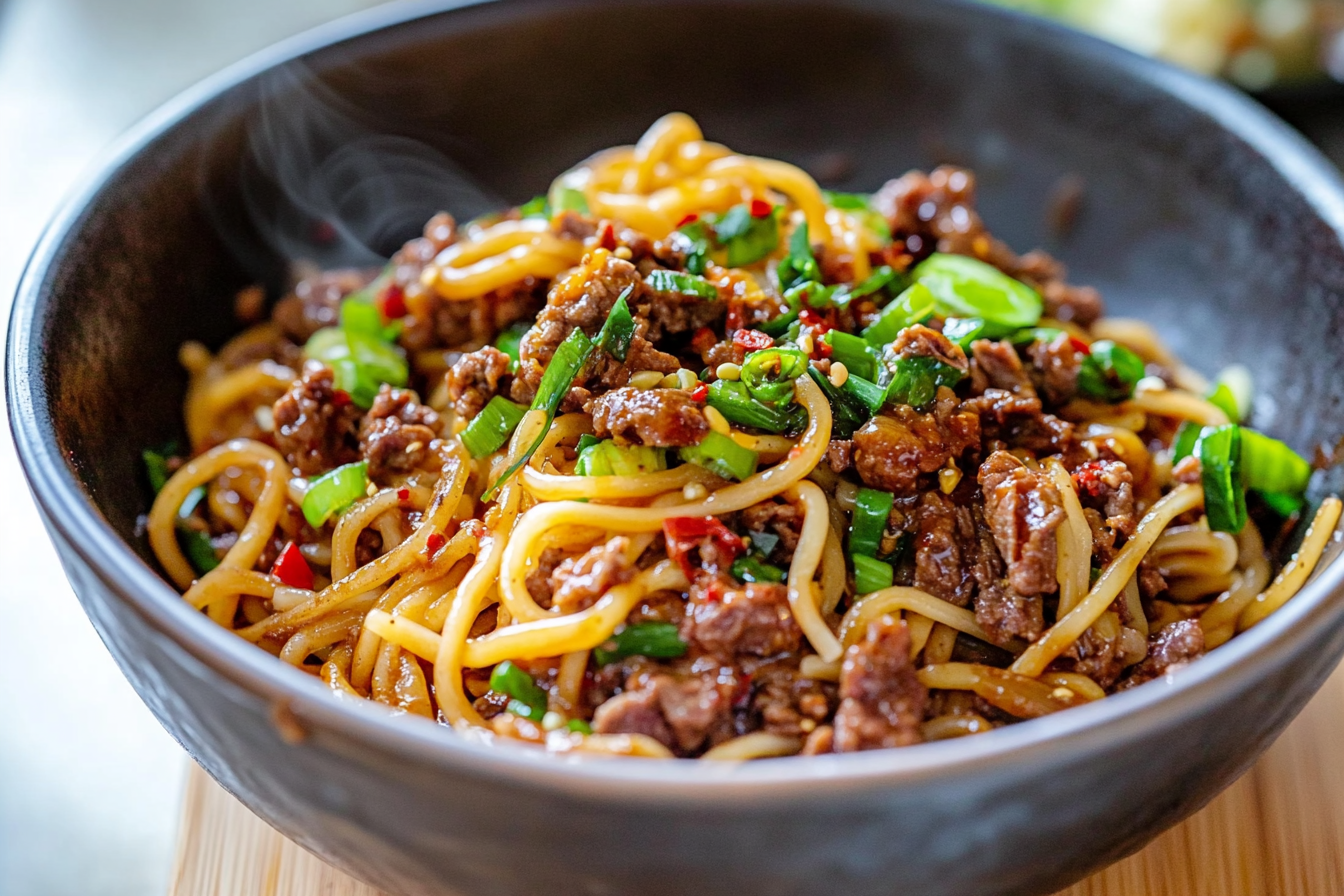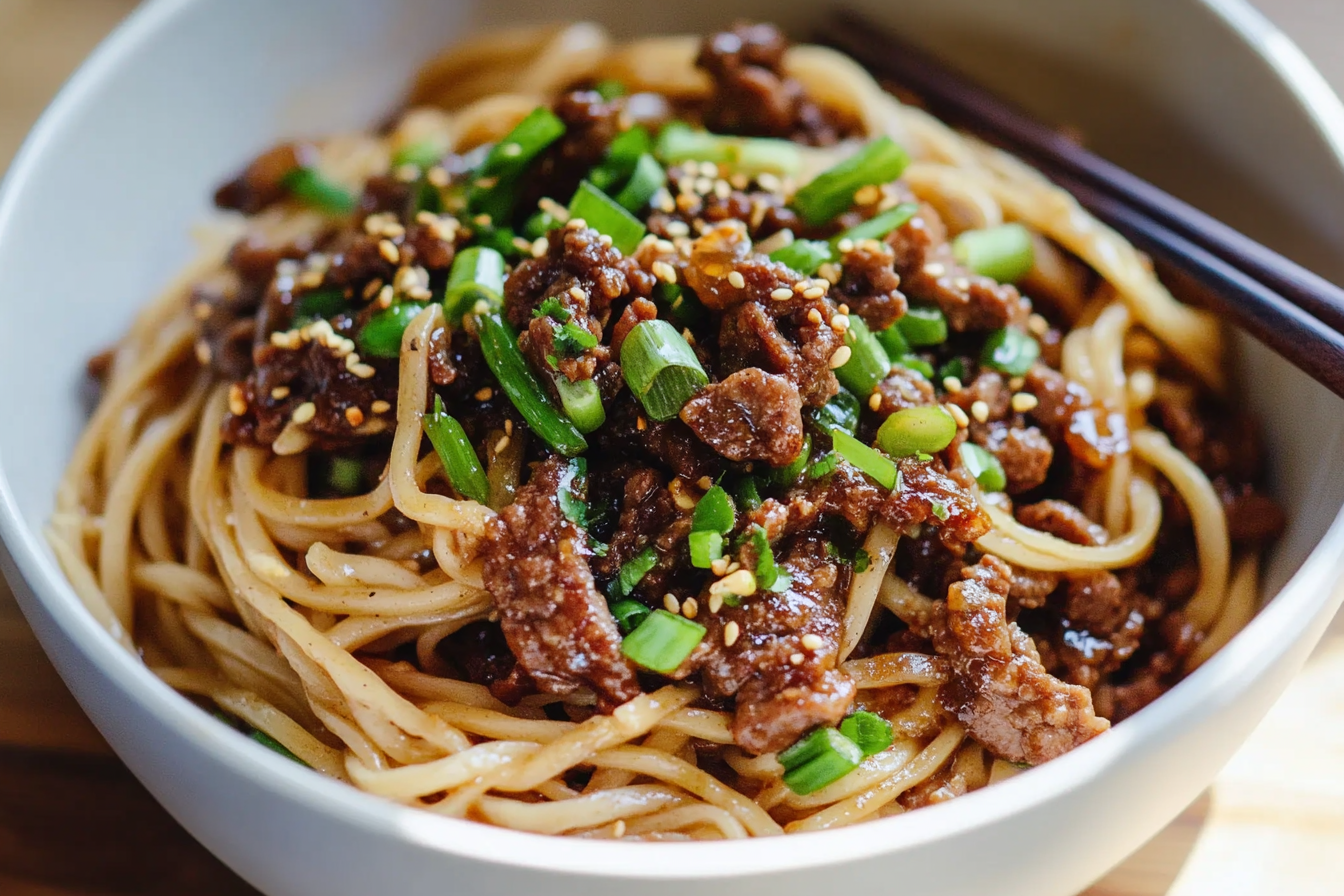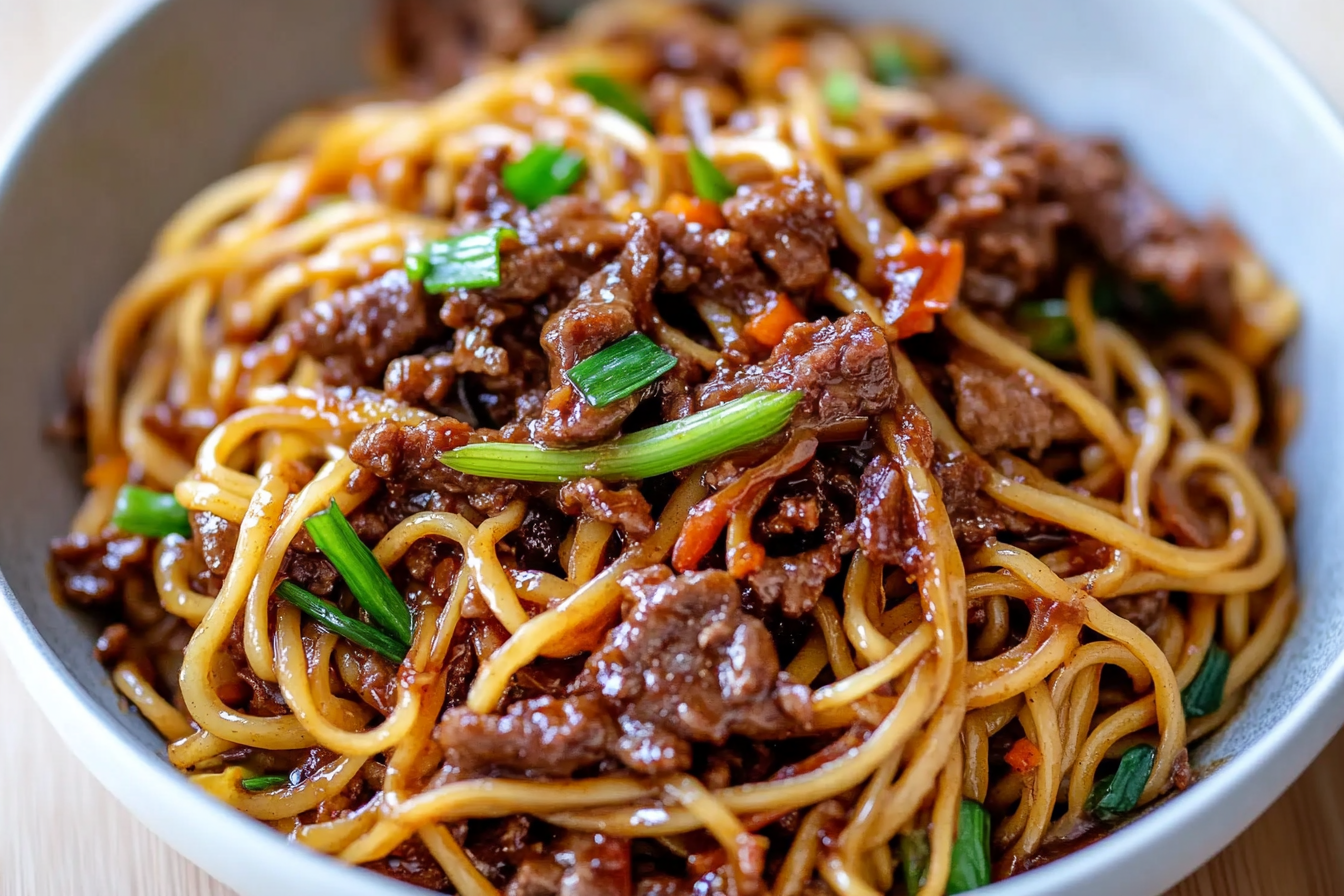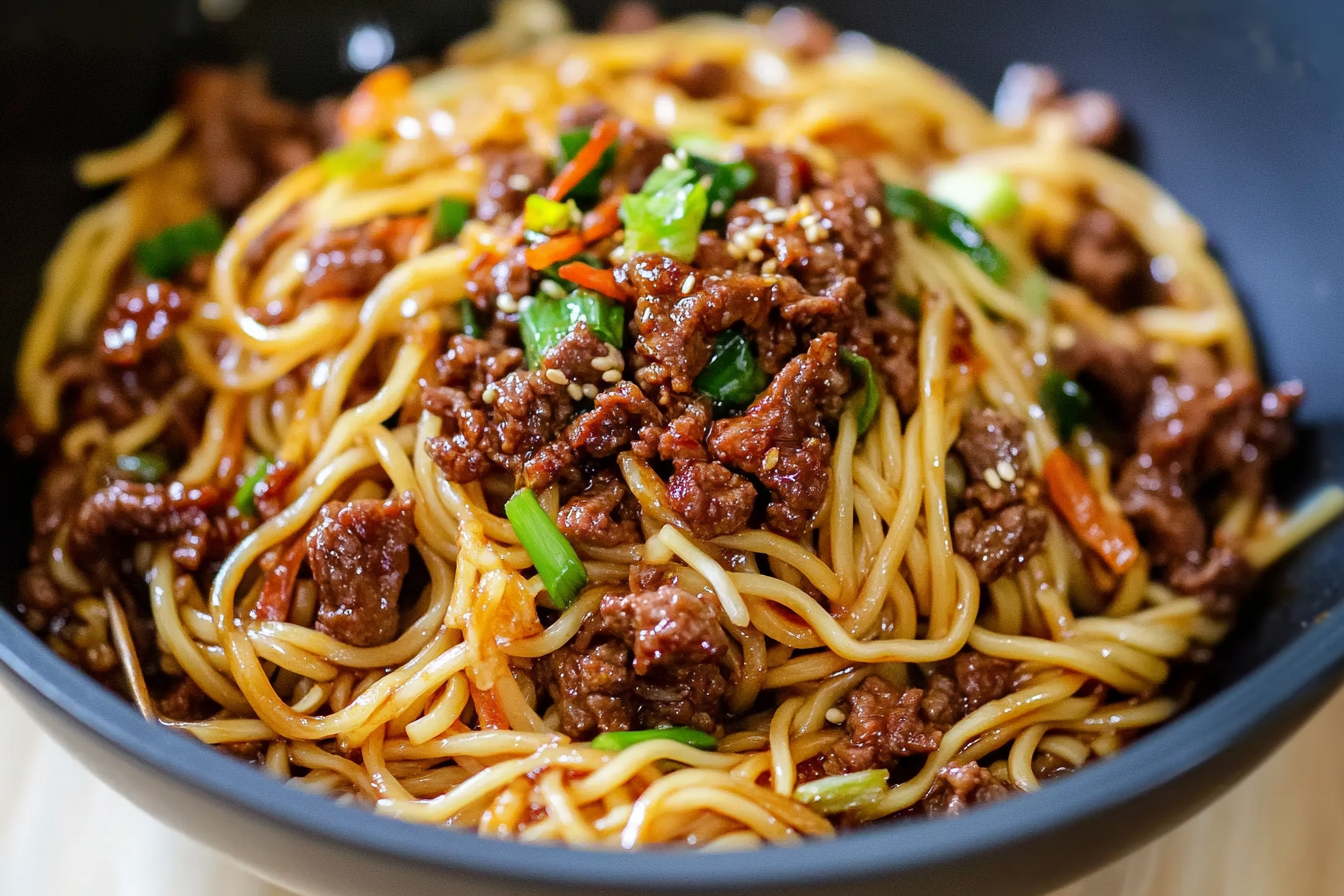Introduction to Sticky Beef Noodles
There’s something enchanting about a dish that seamlessly marries flavors and textures, captivating taste buds and transporting diners to distant lands. Sticky Beef Noodles is one such culinary marvel, a quintessential harmony of Asian ingredients and techniques, often found sizzling in bustling markets and cozy street food stalls. This dish is believed to have roots in the culinary traditions of Southeast Asia, where the combination of savory, sweet, and umami elements create a meal that delights all the senses.
Sticky Beef Noodles encompasses everything great about home cooking: delicious, versatile, and relatively simple to prepare, it brings an exotic flair of restaurant fare into your kitchen. The balance of tender beef, luscious noodles, and glossy sauce speaks to the communal nature of Asian dining, where sharing and abundance are celebrated values. It’s the heart of the meal, a conversation starter, bringing families and friends together around the dining table.
The appeal of Sticky Beef Noodles lies not only in its authentic taste but in its adaptability to the ingredients at hand. As weeknights become busier, home cooks worldwide seek recipes that satisfy without the demand for endless preparation. The dish caters to this need without compromise, capable of swift assembly while maintaining a rich, rewarding depth of flavor. Whether you’re navigating a hectic weekday evening or setting the scene for a leisurely weekend lunch, Sticky Beef Noodles promise to be the savory, comforting delight you’ll return to time and again.
Prepare yourself for an immersive culinary journey, one that ends with a satisfying slurp and a chant of compliments around the table. With Sticky Beef Noodles, you’re not just cooking a meal; you’re crafting a story on your plate, one flavorful chapter at a time.

“`html
Ingredients for Sticky Beef Noodles
- 200g beef sirloin, thinly sliced
- 200g rice noodles or any preferred noodles
- 2 tablespoons soy sauce
- 2 tablespoons oyster sauce
- 1 tablespoon hoisin sauce
- 1 tablespoon sesame oil
- 1 tablespoon vegetable oil
- 2 tablespoons dark soy sauce
- 2 cloves garlic, minced
- 1 tablespoon ginger, minced
- 1 red bell pepper, julienned
- 100g sugar snap peas or green beans
- 1 spring onion, chopped
- 1 tablespoon sesame seeds (optional)
- 1 teaspoon chili flakes (optional)
- Fresh coriander or cilantro for garnish
“`
“`html
Sticky Beef Noodles Preparation Guide
- Start by heating a large pan or wok over medium-high heat. Add 2 tablespoons of vegetable oil and heat until shimmering.
- Add 1 pound of thinly sliced beef strips to the pan, spreading them out to a single layer. Stir-fry for about 3-4 minutes, or until the beef is browned and cooked through. Remove the beef from the pan and set it aside.
- In the same pan, add 1 tablespoon of vegetable oil and heat until shimmering. Add 2 cloves of minced garlic and 1 tablespoon of grated fresh ginger. Stir-fry for about 30 seconds until fragrant.
- Add 1 sliced red bell pepper and 1 cup of sugar snap peas to the pan. Stir-fry for 2-3 minutes, or until the vegetables are tender-crisp.
- Return the cooked beef to the pan. Add 1/4 cup of soy sauce, 3 tablespoons of hoisin sauce, 2 tablespoons of rice vinegar, and 1 tablespoon of honey. Stir well to combine and cook for another 2 minutes, allowing the sauce to thicken slightly.
- Meanwhile, cook 300 grams of Asian egg noodles according to the package instructions. Once cooked, drain the noodles and add them to the beef and vegetable mixture in the pan.
- Toss everything together to ensure the noodles are well-coated with the sticky sauce. Continue to cook for an additional 2-3 minutes, stirring frequently until heated through.
- Remove from heat and transfer the sticky beef noodles to serving plates. Allow to cool for a minute before serving.
“`
Advanced Tips for Successfully Preparing Sticky Beef Noodles
- Marinating for Flavors: To deepen the beef’s flavor, consider marinating it for a longer period, ideally overnight. Use a marinade that includes soy sauce, ginger, garlic, and a hint of brown sugar or honey for a caramelized finish when cooking.
- Use Cornstarch Wisely: Before stir-frying, lightly coat the beef slices with cornstarch. This seals in the juices and creates a slightly crispy texture that complements the stickiness of the sauce.
- Searing the Beef: Invest in a wok to achieve the intense heat needed for a quick sear, ensuring the beef retains a juicy interior while developing a flavorful crust. If a wok is unavailable, a heavy-bottomed skillet works well, but ensure it’s preheated to a high temperature.
- Aromatic Boost: Enhance the aromatics by briefly toasting spices such as Sichuan peppercorns or star anise before adding other ingredients. This can elevate the dish’s complexity significantly.
- Noodle Preparation: Ensure noodles are cooked al dente and rinsed under cold water post-cooking. This halts the cooking process and reduces starchiness, preventing them from becoming overly sticky.
- Layering Sauces: Add sauces gradually and taste as you go. This prevents over-saturation of flavors and allows for precise adjustments.
- Garnishing: For presentation, garnish with fresh herbs like cilantro or Thai basil, and sprinkle sesame seeds or chopped peanuts for added texture.
Common Mistakes and Solutions:
- Avoid overcrowding the pan when cooking beef. It should be cooked in batches to ensure even browning and avoid steaming.
- Don’t overcook vegetables. They should maintain a slight crunch to contrast the tenderness of the beef and noodles.
- Watch sauce consistency; it should coat the noodles and beef without making the dish soupy. Thicken as needed with a cornstarch slurry.
- Pay attention to timing. Add delicate ingredients like green onions or sprouts towards the end to keep them fresh and crisp.

Storing Sticky Beef Noodles
To store any leftovers of your Sticky Beef Noodles, make sure they are cooled at room temperature before transferring them to an airtight container. This helps maintain flavor and texture. For refrigeration, store the leftovers in the fridge where they will last for up to 3-4 days. If you wish to store them for a longer period, place the noodles in a freezer-safe container or resealable freezer bag and freeze for up to 2-3 months.
Reheating Instructions
When you’re ready to reheat the Sticky Beef Noodles, defrost them overnight in the refrigerator if frozen. For reheating, use the stovetop for the best results. Place the noodles in a large pan over medium heat, stirring occasionally until heated through. You may need to add a splash of water or broth to prevent them from drying out. Alternatively, you can use a microwave. Place the noodles in a microwave-safe dish, cover it loosely, and heat them in intervals of 1 minute, stirring in between, until they are thoroughly heated.
Serving Suggestions
Serve the reheated Sticky Beef Noodles straight from the stovetop or microwave for the best experience. You may garnish with fresh herbs, such as cilantro or green onions, for added freshness and flavor. Consider serving them alongside crunchy spring rolls or a refreshing cucumber salad to complement the savory and slightly sweet flavors of the dish. Enjoy with your favorite hot sauce or a squeeze of lime juice to elevate the taste.
“`html
Adapting Sticky Beef Noodles for Different Diets
-
Vegan Alternative:
- Replace beef with tofu or tempeh. Marinate these alternatives to infuse flavor. Expect a slight change in texture; tofu is softer while tempeh offers a more substantial bite.
- Use vegetable broth instead of beef broth to maintain the umami flavor.
- Ensure any sauces used are vegan, opting for soy sauce instead of fish sauce, and checking that the hoisin sauce is vegan.
-
Gluten-Free Alternative:
- Substitute regular noodles with rice noodles or another gluten-free option like zucchini noodles. Rice noodles offer a similar texture, while zucchini adds a fresh crunch.
- Use tamari or a gluten-free soy sauce instead of regular soy sauce to ensure the dish remains gluten-free.
- Check the labels of all sauces and condiments to confirm they are gluten-free.
-
Low-Carb Alternative:
- Swap traditional noodles for spiralized vegetables such as zucchini or shirataki noodles. These alternatives are lower in carbs and calories with a distinct texture, the vegetables adding a fresh twist.
- Use stevia or a similar low-carb sweetener instead of sugar in any sauces.
- Consider cauliflower rice as a base for a different take, which will absorb the flavors similarly to noodles.
“`

“`html
Frequently Asked Questions about Sticky Beef Noodles
Can I use a different type of noodle?
Yes, you can use rice noodles, egg noodles, or even spaghetti if needed. Adjust cooking time according to the type of noodle you choose.
What can I substitute for beef?
Chicken, pork, or tofu can be used as alternatives. Adjust cooking times as chicken and tofu may cook faster.
How do I make the dish less spicy?
Reduce the amount of chili or hot sauce in the recipe. You can also serve with a sweet soy sauce or additional vegetables to balance the heat.
Can I prepare this dish ahead of time?
Yes, you can prepare the sauce and marinate the beef in advance. Cook the noodles and assemble the dish just before serving for best results.
What vegetables can I add?
Common additions include bell peppers, broccoli, snow peas, or carrots. Add them during the stir-fry stage to ensure they cook through.
How do I prevent the noodles from clumping together?
Rinse the cooked noodles with cold water and toss them with a little oil to keep them separated before adding them to the stir fry.
What can I do if the dish is too salty?
Add more vegetables or noodles to dilute the saltiness, or serve it with plain rice to balance the flavors.
Is it possible to make this dish gluten-free?
Yes, use gluten-free soy sauce and rice noodles to make the dish suitable for gluten-free diets.
“`
“`html
Conclusion
This Sticky Beef Noodles recipe is a perfect blend of flavors and textures that will tantalize your taste buds. With its deliciously sticky and savory sauce coating tender beef strips and veggies nestled in the embrace of soft, slurp-worthy noodles, it’s a meal that promises satisfaction in every bite. Quick to prepare and packed with flavor, it is ideal for busy weeknights or a cozy weekend dinner.
If you’ve tried this recipe, I encourage you to share your experience and any personal tweaks you made. Your feedback not only helps others but also fosters a warm cooking community. Feel free to leave a comment below – we’d love to hear how your dish turned out or how you made it your own.
Enjoy your meal! Try this recipe and let us know your thoughts in the comments. 🍽️
“`

